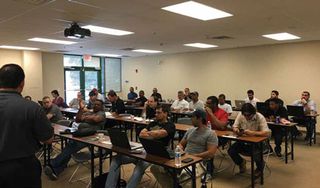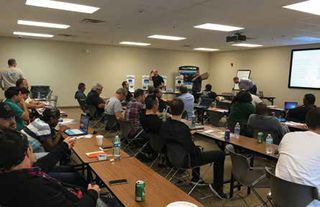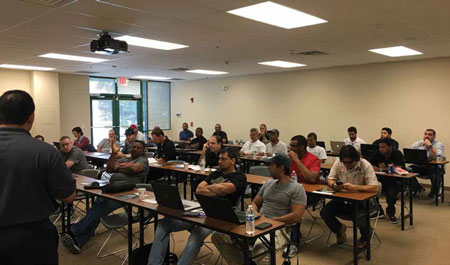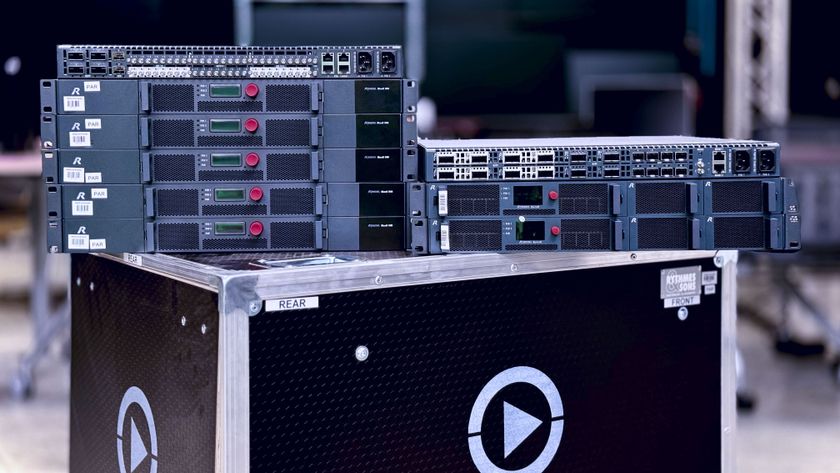The best-designed AV system is rendered less than optimal, at best unless the end user understands how to use it. So what kinds of programs are integrators using to ensure their clients are properly trained on new systems? Let us count the ways.

AVAD offers in-house training sessions at its showrooms to let clients get hands-on with the products. At AVAD, dealers are allowed to bring their end users and customers into the showroom to experience hands-on what the product can do and how it works before buying, said Lei Lei Trock, senior marketing manager for AVAD and AVAD Canada. “The trainings and showroom experiences allow dealers to anticipate the end-user needs and address those needs at system delivery to eliminate many customer callbacks and unnecessary truck rolls.”
AVAD’s system design team offers a very informative class at most Vendopalooza events, covering the available digital signage software. “These systems can be managed by the installer for recurring revenues or can be easily taught to the end user,” Trock said. “AVAD has regional trainings, manufacturer product webinars, and nationwide training events that cover topics ranging from new products and technologies to installation tips and sales tools. Our regional events are designed specific to the locations and are tailored to target the particular vertical markets of customers in that area. Vendopalooza, Commercial Days, and Opportunity Tours are nationwide events, with the same curriculum in different cities.”
In addition, AVAD offers webinar and in-branch trainings for partner brands, such as Panamax’s BlueBOLT. “Nest, Ring, InFocus, Barco, and TiVo are all so easy to install and manage that an installer is really just a safety net for the end user,” she noted.
Timing Is Everything
The perceived success of an installed system lies in the client’s ability to use it, but training after the installation is not the answer. “By then, it’s often too late,” said Michael Goldman, executive director, enterprise strategies and development, Crestron. “The answer to a successful deployment lies in a simple, consistent user experience, a system design that meets organizational goals and expectations, and is easy to support. It’s the upfront work that is critical to ease of use and success, not necessarily backend training.”

AVAD’s system design team offers an informative class at most Vendopalooza events, covering the available digital signage software. Crestron’s approach is to train and empower integrators to properly evaluate client needs and expectations before designing, installing, or programming a system. “By identifying all the stakeholders on the client side and partnering with them, success is guaranteed,” he added. “When the system is installed, they should already be comfortable with the system and its functionality. All that may be needed is to leave them with a two-minute video tutorial they can refer to; showing is better than telling.”
Web-based management software can make it easy for the client to support the technology. “The software acts as a centralized repository of technical documentation (since every room is designed and works the same way, documentation is concise and support is simple), and features remote help-desk capabilities, such as instant message, web cam, IP intercom, and live chat,” Goldman noted. “If there is a question or a problem, the issue can be resolved quickly from anywhere.”
May I Help You?
Integrators have traditionally sold service plans to cover the costs associated with end-user support on installed systems, explained Gary Dixon, sales engineer, installed sound, Audio-Technica. “If a customer’s budget is tight, the service contract is usually the first line item to get the ax. This leaves a big potential for a steep learning curve between the system commissioning and when the end user first uses the system.”
Many times, the end user will call the manufacturer a few weeks after a system has been installed because a product is not performing as expected. “I estimate that 95 percent of the time these calls could be avoided if the end user had been able to absorb and process all of the information provided by the integrator/consultant during the initial walk through,” he said.
So who owns the responsibility when the customer cannot meet the expense of extended training and the integrator/consultant has provided what was discussed in the original scope of work? The end user still has a few options.
“If they have a system that is not being used to the fullest technical extent, they can reach out to a technical sales person,” Dixon advised. “As we tend to be just one part of a multi-manufacturer system, we typically assist end users post-installation. Extensive training is conducted on our products with the integrators, and is facilitated through our field sales and technical sales staff. When questions or problems on a system arise, end users usually start calling manufacturers down the signal path, starting at the microphone.”
Audio-Technica’s audio solutions department is dedicated to phone, email, and web support for audio questions big and small. “We love to talk with end users,” Dixon said, “so keep the calls coming. We have experts on hand to talk microphones and just about everything else down the signal chain. End users see the manufacturers as the technical experts, and we put those experts on the front line, in department. We are always happy to spend the necessary time and attention to help a customer, end user, or AV integrator understand our technology and industry best practices. The end user wants more than just to see a paperweight with our company logo.”
Keep Them Happy
Ultimately, the benefits integrators derive are from satisfied customers, not from training, Goldman said. “Happy customers are more profitable, period. If they are happy with the experience the integrator provided, the clients will buy more, they will make buying decisions faster, they won’t return product or call for technical support and pull labor out of the field, and they will advocate on behalf of the integrator.”
Many commercial clients, whether in higher education, high tech, or government, talk to each other and share experiences, he noted. “If a client has a great experience, the integrator can expect the phone to ring—only this time the call will be from a new customer and not about a technical issue.”
Karen Mitchell is a freelance writer based in Boulder, CO.
Frequent Updates
With trends in the AV industry evolving at such a brisk pace, it’s essential to update training services and product offerings as needed.
The industry is moving toward employing more technical sales people, Dixon said. “I see more CTS certifications every year by InfoComm. Technical sales people are a benefit for both the integrator and the end user, as a ‘sales call’ can be used to teach the end user about his or her existing system. This should not be seen as a ‘time suck’ by the integrator; with the sales person confirming a particular system operation, the end user will gain confidence and a desire to do more with the system, usually opening the door for an upgrade.”
AVAD’s nationwide webinars are a hit for dealers because they can take part in valuable training from the luxury of their homes or offices whenever they have time, Trock said. “Last week, we hosted a webinar with Bose Professional, and we had a large turnout with a lot of positive feedback from our dealers. The dealers love that each of our webinars is recorded and later posted on our online portal, so they can reference them on demand.”
The key is to focus on what people actually want to do in a room, and not to focus on the technology, Goldman concluded. “Too often our industry is enamored with systems and forgets that people have to use them. Let form—or in our case, system and GUI design—follow function. If you let the clients drive the process, allow them to tell you what they want to do, and design the system around that, they’ll already know how to use it.”
—KM













